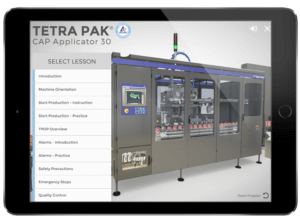Tetra Pak, the largest food packaging company in the world, approached Heartwood with a prevalent training problem – not enough equipment available for training, long classroom times and a need for more ‘learn-by-doing’, without disrupting an actual production line operation. The post below chronicles their starting problem, the deployed solution and the measurable results from testing conducted by their team, with their customers.
Download the Tetra Pak Case Study PDF here.
BACKGROUND: Tetra Pak’s mission was to adopt a new training method to project them into the digital age. Training is deployed for Technicians, Mechanics and Tetra Pak Customers as well. Past training was conducted via PowerPoint in the classroom, Hands-on training and on-the-field learning.
With Tetra Pak’s mission, “Protect what’s good”, including keeping waste as sustainable as possible, virtual interactive training became a fit to reduce costs and waste within training.
PROBLEM: Tetra Pak’s customers train, on average, 600 line operators annually. The customer equipment is fully utilized for processing and packaging product while line operators are too busy working the equipment to practice and reinforce learning during production runs.
 SOLUTION: Develop a 3D interactive training application that does not require use of expensive backup equipment or live training. The training will be used at Global Training Centers and can be sold to Tetra Pak’s customers, creating additional revenue. The first deployment (and focus group) was for the Cap 30 Flex Applicator Machine for a customer in Estonia. They were resource constrained to send machine operators for off-site training involving 2-day production downtimes.
SOLUTION: Develop a 3D interactive training application that does not require use of expensive backup equipment or live training. The training will be used at Global Training Centers and can be sold to Tetra Pak’s customers, creating additional revenue. The first deployment (and focus group) was for the Cap 30 Flex Applicator Machine for a customer in Estonia. They were resource constrained to send machine operators for off-site training involving 2-day production downtimes.
GOAL: Test and assess the virtual training tool at a customer site – on both operators and technicians.
This focus group was tasked to learn and interactively utilize the application as a real life training group. The end goal was to determine if training could be deployed in this digital fashion to various degrees of economic and educational backgrounds while reducing time to train, increase retention and reduce the need for scheduling training, travel and machine downtime.
FOCUS Q&A Highlights:
How easy was the training application to navigate?
– The participants found the application easy to navigate after a couple of minutes of testing.
Preferred to have taken the training on a computer? Was the time (2hrs) enough?
– 83% of participants had never used an iPad before. iPad seems to be the preferred platform for this kind of training. Excitement and curiosity was apparent as they navigated through the application with little support or guidance. A few participants finished after one hour.
How confident do you feel to operate the CAP30 on your own?
– Good introduction to the machine and gave a good understanding of what the machine does and how it works.
CONCLUSIONS:
Training Time Reduction: 50%!
Training Days (Before): 2
Training Days (After): 1
Hrs. Given on iPad: 2
Language: Estonian
“The concept of Virtual Training prior to hands-on training on a machine seems to be an effective, inspiring training method – that encouraged the participants to explore and understand the handling of the machine. Some were inspired by the score feedback in the practice lessons and repeated the lessons until the score was perfected”
– Tetra Pak Training Instructors
From the users’ perspective, the 3D interactive application allows technicians to actually practice the procedures and learn anytime, anywhere – without being in front of the equipment. From Tetra Pak’s perspective, the marginal cost of training another set of students is practically zero (vs. costly inconvenient live training on production machines).
Download the Tetra Pak Case Study PDF here.
Want the same results as Tetra Pak? CONTACT US – [email protected] or call 888.781.0274 ext. 701


